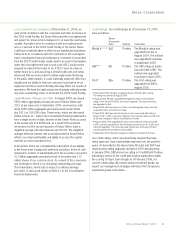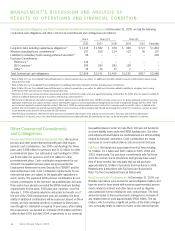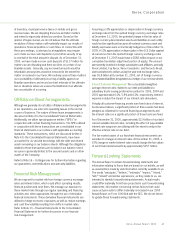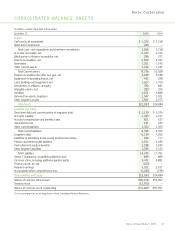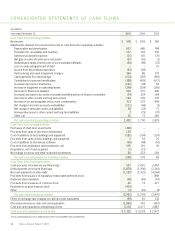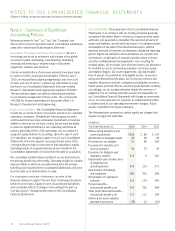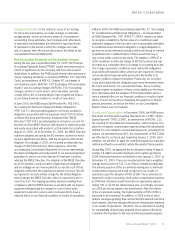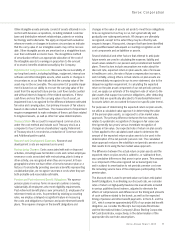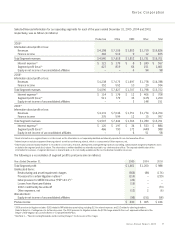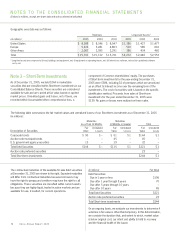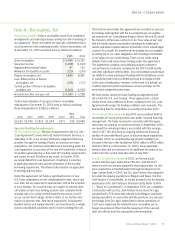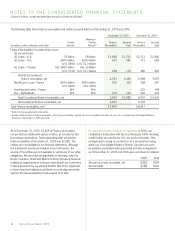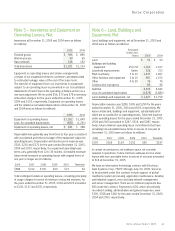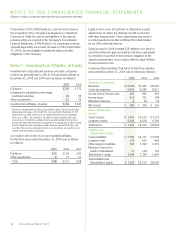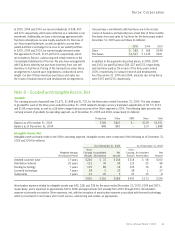Xerox 2005 Annual Report Download - page 61
Download and view the complete annual report
Please find page 61 of the 2005 Xerox annual report below. You can navigate through the pages in the report by either clicking on the pages listed below, or by using the keyword search tool below to find specific information within the annual report.
Xerox Corporation
53
the sales occur. We also similarly account for our estimates of
sales returns and other allowances when the sales occur based
on our historical experience.
Supplies: Supplies revenue generally is recognized upon shipment
or utilization by customer in accordance with sales terms.
Revenue Recognition for Leases: Our accounting for leases
involves specific determinations under SFAS No. 13, which
often involve complex provisions and significant judgments.
The two primary criteria of SFAS No. 13 which we use to classify
transactions as sales-type or operating leases are (1) a review
of the lease term to determine if it is equal to or greater than
75% of the economic life of the equipment and (2) a review of
the present value of the minimum lease payments to determine
if they are equal to or greater than 90% of the fair market value
of the equipment at the inception of the lease. Our sales-type
lease portfolios contain only normal credit and collection risks
and have no important uncertainties with respect to futurecosts.
Our leases in our Latin America operations have historically
been recorded as operating leases, given the cancellability of the
contract or because the recoverability of the lease investment
is deemed not to be predictable at lease inception.
The critical elements that we consider with respect to our lease
accounting arethe determination of the economic life and the fair
value of equipment, including the residual value. For purposes of
determining the economic life, we consider the most objective
measureto be the original contract term, since most equipment
is returned by lessees at or near the end of the contracted term.
The economic life of most of our products is five years, since
this represents the most frequent contractual lease term for our
principal products and only a small percentage of our leases
have original terms longer than five years. There is no significant
after-market for our used equipment. We believe that five years is
representative of the period during which the equipment is expected
to be economically usable, with normal service, for the purpose
for which it is intended. Wecontinually evaluate the economic
life of both existing and newly introduced products for purposes
of this determination. Residual values are established at lease
inception using estimates of fair value at the end of the lease
term. Our residual values areestablished with due consideration
to forecasted supply and demand for our various products,
product retirement and future product launch plans, end-of-lease
customer behavior, remanufacturing strategies, competition
and technological changes.
The vast majority of our leases that qualify as sales-type are
non-cancelable and include cancellation penalties approximately
equal to the full value of the lease receivables. A portion of our
business involves sales to governmental units. Governmental
units arethose entities that have statutorily defined funding or
annual budgets that aredetermined by their legislative bodies.
Certain of our governmental contracts may have cancellation
provisions or renewal clauses that are required by law, such as
1) those dependant on fiscal funding outside of a governmental
unit’s control, 2) those that can be cancelled if deemed in the best
interest of the governmental unit’s taxpayers or 3) those that must
be renewed each fiscal year, given limitations that may exist on
entering into multi-year contracts that are imposed by statute.
In these circumstances, we carefully evaluate these contracts to
assess whether cancellation is remote because of the existence
of substantive economic penalties upon cancellation or whether
the renewal is reasonably assured due to the existence of a
bargain renewal option. The evaluation of a lease agreement
with a renewal option includes an assessment as to whether
the renewal is reasonably assured based on the intent of such
governmental unit and pricing terms as compared to those of
short-term leases at lease inception. We further ensure that the
contract provisions described above are offered only in instances
whererequired by law. Where such contract terms are not legally
required, we consider the arrangement to be cancelable and
account for it as an operating lease.
Aside from the initial lease of equipment to our customers, we may
enter subsequent transactions with the same customer whereby
we extend the term. We evaluate the classification of lease exten-
sions of sales-type leases using the originally determined economic
life for each product. Theremay be instances wherewe enter into
lease extensions for periods that arewithin the original economic
life of the equipment. These are accounted for as sales-type leases
only when the extensions occur in the last three months of the
lease term and they otherwise meet the appropriate criteria of
SFAS No. 13. All other lease extensions of this type are accounted
for as direct financing leases or operating leases, as appropriate.
Revenue Recognition Under Bundled Arrangements: We sell most
of our products and services under bundled lease arrangements,
which typically include equipment, service, supplies and financing
components for which the customer pays a single negotiated
fixed minimum monthly payment for all elements over the con-
tractual lease term. These arrangements typically also include an
incremental, variable component for page volumes in excess of
contractual page volume minimums, which are often expressed
in terms of price per page. The fixed minimum monthly payments
are multiplied by the number of months in the contract term to
arrive at the total fixed minimum payments that the customer is
obligated to make (“fixed payments”) over the lease term. The
payments associated with page volumes in excess of the minimums
are contingent on whether or not such minimums are exceeded
(“contingent payments”). The minimum contractual committed
page volumes are typically negotiated to equal the customer’s
estimated page volume at lease inception. In applying our lease
accounting methodology, we only consider the fixed payments
for purposes of allocating to the relative fair-value elements of the
contract. Contingent payments, if any, are inherently uncertain and
therefore are recognized as revenue in the period when the cus-
tomer exceeds the minimum copy volumes specified in the contract.
Xerox Annual Report 2005


